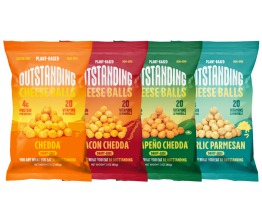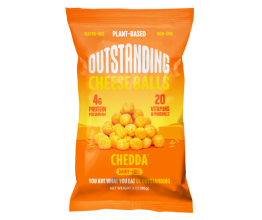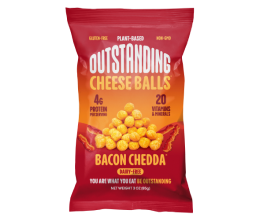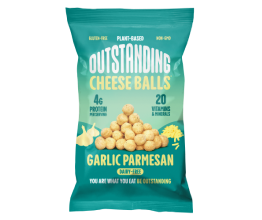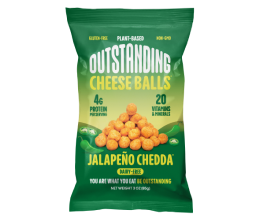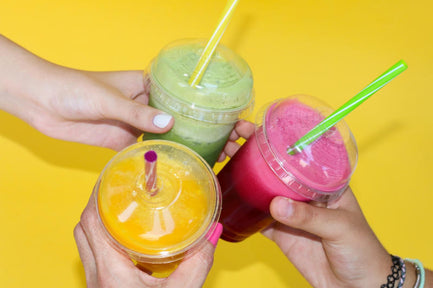Ultimate Guide to Healthy Snacking for Adults
It’s no secret that many Americans struggle with bad eating habits. Part of it is the culture we live in - advertisements and social networks show us greasy fast foods that tap our innate desire for caloric overload—and they’re drool-worthy, let’s be honest.
You can’t throw on the TV for three minutes without seeing the next big double-bacon burger meal deal, complete with super-sized soda and fried.
Pair that media environment with stress, time pressure, and other lifestyle problems like inactivity and smoking - and we’re dealing with a nationwide health crisis—crazy, we know.
To commit to your health, you need to snap out of society’s programming and discover a way of eating that makes you never want to go back to your old, eating-an-entire-pizza-and-then-a-carton-of-ice-cream-in-one-sitting ways.
The shift will take some effort and energy upfront, but you’ll soon realize how easy and (dare we say it) fun it can be to eat well and show the path to people in your life.
In this article, we’re mapping out the must-know info for healthy eating and offering some key rules to remember on your journey. We’ll even throw in some essential ingredients and snack ideas to make things easier. Let’s jump in!
Macronutrient Balance and Portions
At the foundation of nutrition, there are three macronutrients that account for every calorie we eat: fat, protein, and carbohydrates.
Let’s get one thing out of the way right now: None of these “macros” are inherently good or bad.
None of them should be avoided entirely. In fact, they’re all important to balancing the body’s composition of fat, organ, and muscle tissue while maintaining energy levels, metabolism, and mental focus.
That’s why those “all-or-nothing” diets that restrict you from all carbs or state you should only eat protein are generally not that great for you. We’re looking at you, juice cleanses.
They might be effective in some extreme cases, but for the average person, your’re going for balance and sustainability. We all know what happens when we go 100% on a crash diet - you find yourself in the pantry at midnight stuffing your face with a bag of fun-sized candy bars.
A healthier way to approach macronutrients is to stick with a consistent ratio in every meal you eat.
For weight loss, try keeping carbs to around 30%, with moderate fat and higher protein. If you’re trying to make gains at the gym, up the carbs to 40% or 50% for more energy and faster recovery.
On the topic of carbs, your sources make a big difference in digestion, absorption, and blood sugar levels. Be conscious of the types of carbs you eat at each meal.
“Fast” carbs (white bread, white rice, bagels, cereal, pasta) behave more like sugars and give us a quick energy blast, followed by a crash and persistent cravings. Translation: not what you’re looking for. “Slow” carbs (oats, whole grains, ancient grains like quinoa, brown rice) provide us with more even, sustained energy and keep us full for longer. Stick with slow carbs at first if your goal is to drop some pounds (even though we think you’re perfect just the way you are).
Getting those healthy fats and proteins is where many people struggle, so find some quality sources from animal products or legumes (if you’re going plant-based). Scrambled or hard-boiled eggs in the morning and the occasional protein shake will help ensure you hit those daily protein numbers and reduce your cravings for carbs at first. Plus, snacks like hummus (since it's made from chickpeas) and whole wheat pita, nut butters like peanut butter and almond butter can be a great source of protein, as well as some of those healthy fats. Also, they’re delicious, so there’s that.
Healthy fats are drastically different from those found in fried foods or mass-produced pastries. These are key nutrients that promote high-functioning organs and cognition, as well as proper digestion, elimination, immune response, and even sexual function. It sounds crazy, but not all fat is bad!
To keep those healthy fats flowing, keep some natural butter, ghee (clarified butter), olive oil, or coconut oil on hand at all times! Of course, we’re not telling you to stick a spoon in a tub of butter—use these in recipes for the best effects. Focus on protein sources like fish (if you're pescatarian) instead of red meat, and you’ll soon feel the positive effects of healthy fats.
When you stick to natural foods and balance your macros in every meal, you’ll be able to ignore that little voice in your head telling you to eat just one more chip, and then just one more. Healthy habits will be easier to maintain, and you can take your mind off cravings as you go about your day.
Micronutrients: Organic and Inorganic
You’ve got the basics on macros, but don’t forget about those vitamins and minerals that often go overlooked. These are the organic and inorganic micronutrients that support our bodies’ vital functions and allow us to perform at peak capacity.
Just because they’ve got the “micro” label doesn’t mean they aren’t important—we’re talking small but mighty, people! Water-soluble vitamins, for example, are powerful coenzymes that help trigger key reactions in our cells and maximize our energy output in organs and muscles.
The B-vitamins and Vitamin C are all water-soluble and are great for you.
Whole grains, lean meats, veggies like zucchini, and legumes like black beans, are all great sources of these water-soluble vitamins, which is a great reason to fill your plate with all of the above.
Fat-soluble vitamins are important for functions such as immunity, eyesight, and protection against oxidation in the cells - AKA antioxidants. Vitamins A, D, E, and K are the big four fat-soluble vitamins present in foods like fish, dairy, legumes, nuts, and leafy greens. Basically, if it’s a letter in the alphabet, you want it.
We’ve linked to a full list of all the key micronutrients and the functions they serve, so reference the master list and start throwing these items in your grocery cart (and close your eyes as you walk by the toaster pastries—you can do it!).
Hydration and Supplements
Real, natural, unprocessed foods should make up the majority of what you eat each day. Rather than drinking calories, stick with clean, filtered water, and make sure you get enough. Hydrate or die-drate, are we right?
Liquid calories are a major cause of unwanted weight gain and blood sugar problems these days, and removing them from the equation is a smart first step. That means no sodas, no fruit juices, and minimal coffee or tea.
When you allow water as the only liquid to pass your lips, you can instantly cut out several hundred calories from your daily consumption and keep the stomach full throughout the day to combat sneaky cravings.
If you’re always busy and can’t necessarily get the proper amount of veggies and fruits at each meal, consider taking a morning multivitamin to max out those daily recommended values. Other supplements like fish oil can help you with Omega-3 fatty acids, while spice capsules like turmeric can combat inflammation and boost immunity.
Don’t get carried away with supplements, though. Actually eating real food is way better for you - but it’s not a bad idea to have some on hand in a pinch.
Plant-Based Snacking
Maybe you’re combatting high cholesterol or just want to steer clear of animal products for a while. Millions of people embrace the plant-based diet each year as a way to accelerate their health and fitness goals. We are so on board.
A plant-based diet is surprisingly easy to follow if you substitute high-protein foods for your typical portions of meat at each meal. Eggs are a superfood that can be incorporated at breakfast, lunch, and dinner, and legumes and dairy can also play key roles. Try snacking on some crispy, roasted edamame or a trail mix full of nuts like cashews and pecans, dried fruit, and even a bit of dark chocolate for something sweet. If you don't love legumes and you're just vegetarian, not vegan, try some Greek yogurt (ideally plain, so you avoid the added sugar) topped with chia seeds or flaxseed for some crunch. You could even make a yogurt parfait using all kinds of seasonal fresh fruits, from watermelon to berries—how's that for a healthy snack idea?
Things get tougher if you go 100% vegan and take all animal products off the menu, but you can still hit your daily protein needs with ingredients like tofu, seitan, and tempeh.
Plant-based eating takes a little extra planning, but it’s surprisingly easy to hit your daily macronutrient needs with the many offerings available today. Plus, you’ll have no trouble getting those micronutrients in order if your main focus is veggies, fruits, whole grains, and legumes. Okay, we know that’s not what you’re thinking about when you’re grabbing a snack, but we promise that it can taste good, too.
If the plant-based diet looks appealing, but you aren’t ready to abandon animal products altogether, reduce your portions of meat each day and gradually make the shift over time. Don’t jump all in at once, and the experience will be much easier to manage.
Rethinking Snack Foods
Planning meals isn’t the hard part for most people as they move towards healthy eating. Snacking is where it gets tough. We all find ourselves stressed or bored from time to time, craving a sugary or starchy snack, but it’s almost all junk at the convenience store or vending machine.
The problem is that when we get hungry and annoyed, our rationale tends to fly out the window, and we’re back to our old ways with stuff like candy bars, sugary drinks, or fast food. Unfortunately, though, when you look at the list of healthy foods, it's pretty unlikely that tortilla chips and ice cream are going to make the list of ideal afternoon snacks—you don't have to be a dietitian to know that.
Once again, planning ahead is literally going to save your life, especially when it comes to snacks. Keep some veggies in the fridge ready for chopping (or veggies that don't need to be cut, like cherry tomatoes), have yogurt, fresh guacamole, or cottage cheese ready for scooping, and be prepared to blend up a green juice or smoothie if your sweet tooth needs satisfying. Stay away from pre-packaged granola bars, because most of the time, these have a whole bunch of added ingredients that make not, well, not quite as healthy as you'd think.
For something crunchy and flavorful, try out our PigOut Pigless Pork Rinds - five fantastic flavors and plenty of protein to keep you going.
Our Outstanding Puffs are also freaking delicious, and loaded with enough micronutrients to make your heart sing!
It seems like a lot to take in, we know. But healthy eating doesn’t have to be a hassle. That’s what we believe at Outstanding Foods, and we hope this guide can help get you on track to be a better you!
Sources:
Healthy eating for older adults | Harvard Health Blog
Healthy Eating for a Healthy Weight | Healthy Weight, Nutrition, and Physical Activity | CDC
